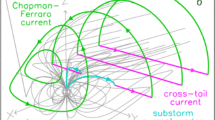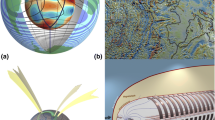Summary
The basic thesis of this paper is that the proper scope of meteorology should include, besides the earth's atmosphere, the sun's atmosphere (the solar corona), the associated interplanetary magnetic field, and lunar modulation of this environment. Recent advances in space science have enabled us to make direct measurements in this region for the first time. The shape and characteristics of the magnetosphere have been completely redefined during the last ten years from a simple magnetic dipole to the present model with an elongated tail stretched out by the solar wind. The interplanetary magnetic field has been defined with its spiral structure and sectors tied into the solar surface. This provides a magnetic link between the sun and earth. It is probable that extra-terrestrial factors do play a role in regulating weather, although the extent of this influence remains to be determined. Possibly such effects are most significant or easily detectable in the realm of atmospheric electricity. In view of the limitations in our present knowledge of all the variables responsible for regulating weather, it would seem appropriate to pursue the study of extra-terrestrial influences. Such research could lead to a better understanding of atmospheric circulation, precipitation mechanisms and thunderstorms. The field of meteorology which might particularly benefit from such research is long range weather forecasting.
Similar content being viewed by others
References
B. Bell andR. J. Defouw,Dependence of the lunar modulation of geomagnetic activity on the celectial latitude of the moon, J. Geophys. Res.71 (1966), 951–957.
Bibliography on lunar influences on atmospheric and geophysical phenomena,W. Nupen andThuronyi (compilers), Meteor. Geoastrophys. Abstracts14 (1963), 3958–4019.
E. K. Bigg,Lunar and planetary influences on geomagnetic disturbances, J. Geophys. Res.68 (1963), 4099–4104.
E. K. Bigg andG. T. Miles,The results of large-scale measurements of natural ice nuclei, J. Atmos. Sci.21 (1964), 396–403.
C. M. Botley,The aurora and the weather, Weather20 (1965), 117–118.
E. G. Wowen,A lunar effect on the incoming meteor rate, J. Geophys. Res.68, (1963), 1401–1403.
D. A. Bradley, M. A. Woodbury andG. W. Brier,Lunar synodical period and widespread precipitation, Science137 (1962), 748–749.
G. W. Brier,Lunar tides, precipitation variations and rainfall calendaricities, Trans. N. Y. Acad. Sci. (1965), 676–688.
G. W. Brier andD. A. Bradley,Lunar synodical period and precipitation in the United States, J. Atmos. Sci.21 (1964), 386–395.
C. E. P. Brooks,Variation of the annual frequency of thunderstorms in relation to sunspots, Quart. J. Roy. Meteor. Soc.60 (1934), 153–165.
J. A. Chalmers,Atmospheric Electricity, 2nd ed. (Pergamon Press, London 1967), 399–433.
J. F. Clark,The fair weather atmospheric electrical potential and its gradient, doctoral thesis, University of Maryland (1956), 151 pp.
W. E. Cobb,Evidence of a solar influence on the atmospheric electric elements at Mauna Loa Observatory, Mon. Weath. Rev.95 (1967), 905–911.
R. K. Cole andE. T. Pierce,Electrification in the earth's atmosphere for altitudes between 0 and 100 kilometers, J. Geophys. Res.70, 2735–2749.
H. W. Dodson andE. R. Hedeman, 1964:An unexpected effect in solar cosmic ray data related to 29.5 days, J. Geophys. Res.69, 3965–3972.
A. YaDriving andA. I. Smirnova, B. (Izv.) Acad. Sci. USSR, Geophys. Ser. No. 3 (1958), 187–191.
C. Dubs, R. Filz, L. Katz, D. Smart, A. Weinberg andK. Yates,Corpuscular radiation, inHandbook of Geophysics (McGraw-Hill, New York,) 1965, 17–25.
J. Egedal,On tides in the upper atmosphere, Nature124 (1929), 913.
H.-J. Fischer,Die elektrische Spannung zwischen Ionosphäre und Erde, doctoral thesis, Astronomisches Institut der Universität Tübingen, Weissenau, Germany (1962).
H. Flohn,Solar Korpuskular-Ausbüche und Gewitterfrequenz, in H. Israël (ed.),Das Gewitter (Akademische Verlagsgesellschaft Geest & Portig, Leipzig 1950), 143–150.
H. Flohn,Solare Vorgänge im Wettergeschehen, Archiv. für Meteor. Geophys. und Bioklim [A] 3 (1951), 303–329.
O. H. Gish,Evaluation and Interpretation of the columnar resistance of the atmosphere, Terr. Mag. and Atmos. Electr.49 (1944), 159–168.
L. Harang,The aurorae (John Wiley & Sons, New York 1951), 44.
B. Haurwitz,Atmospheric tides, Science144 (1964), 1415–1422.
W. N. Hess, G. D. Mead andM. P. Nakada,Advances in particles and field research in the satellite era, Rev. Geophys.3 (1965), 521–570.
G. W. Hurst, letter to the editor, Met. Mag.83 (1954), 281.
H. Ispaël 1961,Atmosphärische Elektrizität, Teil II (Akademische Verlagsgesellschaft Geest & Portig, Leipzig 1961), 52.
M. Lethbridge,Solar-Lunar variables, thunderstroms and tornadoes, Dept. of Meteor. Report, College of Earth and Mineral Sciences, Penn State Univ. University Park (10 June 1969), 58 pp.
M. Lethbridge, personal communication (1969).
Ya. I.Likhter, V. P. Kolokolov andZ. P. Kleimenova,Thunderstorm activity and that of the sun, unpublished manuscript submitted to the Fourth Int. Conf. on Atmos. Electr., Tokyo (1968).
W. I. Linlor,Electric fields in space and on lunar surface, inS. Coroniti andJ. Hughes (eds),Planetary electrodynamics, Vol. 2 (Gordon & Breach New York, 1969), 369.
N. J. Macdonald andW. O. Roberts,The relationship of 300 mb circulation changes to geomagnetic disturbances from 1952 to 1958, Inst. Solar Terrest. Res., High Altitude Observatory, Univ. Colo. Rept. 7 (1958).
N. Macdonald andW. O. Roberts,Further evidence of a solar corpuscular influence on large-scale circulation at 300 mb, J. Geophys. Res.65, (1960), 529–534.
R. Markson, C. B. Moore andB. Vonnegut,Measurement of the atmospheric potential by means of a tethered balloon and high voltage dc power supply (1970), manuscript in preparation.
F. C. Michel, 1967:Model of solar wind structure, J. Geophys. Res.72, (1967), 1917–1932.
NCAR Technical Note, TN-8,Proceedings of the seminar on possible responses of weather phenomena to variable extraterrestrial influences, Natl. Center for Atm. Res., Boulder (1965), 229 pp.
N. F. Ness,The magnetohydrodynamic wake of the moon, J. Geophys. Res.70, (1965), 517–534.
T. Ogawa andY. Tanaka,Balloon measurements of atmospheric electric potential gradient, J. Geomag. and Geoelectr.19 (1967), 307–315.
R. Reiter,Relationships between atmospheric electric phenomena and simultaneous meteorological conditions, Vol. 1, Air Research and Development Command, U.S. Air Force (1960), 168–172.
Reinhold Reiter,Solar flares and their impact on potential gradient and air-earth current characterictics at high mountain stations, Pure and Appl. Geophys.72 (1969), 259–267.
W. O. Roberts,Stratospheric circulation and auroral activity, NCAR Tech. Note, TN-8, National Center for Atmos. Res., Boulder (1965), 189–196.
J. G. Roederer,High energy solar particle events, inH. Odishaw (ed.),Research in geophysics, Vol. 1 (M.I.T. Press, Cambridge 1963), 126.
K. Sao,Correlation between solar activity and the atmospheric potential gradient at the earth's surface in the polar regions, J. Atmos. Terr. Phys.29 (1967), 213–216.
J. B. Shaw, letter to editor, Met. Mag.83 (1954), 281.
R. H. Simpson,Liquid water in squall lines and hurricanes at air temperatures lower than −40°C, Mon. Weath. Rev.91 (1963), 687–693.
C. G. Stergis, G. C. Rein andT. Kangas,Electric field measurements in the stratosphere, J. Atmos. Terr. Phys.11 (1957), 77–82.
H. L. Stolov,Further investigations of a variation of geomagnetic activity with lunar phase, J. Geophys. Res.70 (1965), 4921–4926.
H. J. Smith and Ev. P.Smith,Solar Flares (MacMillan & Co., New York, 1963), 227.
P. Stubbs,Why should the moon affect the weather?, New Scientist, No. 329 (1963), 507–509.
P. F. Twitchell,Geomagnetic storms and 500 mb through behavior, B. Geophysique, No. 13, Montreal (1963), 69–84.
N. C. Varshneya,Detecting radiation with a supercooled liquid, Nature223 (1969), 826–827.
B. Vonnegut, proposal to the Office of Naval Research submitted by Arthur D. Little, Inc., Cambridge, Massachusetts (1958).
B. Vonnegut, personal communication (1968).
John M. Wilcox,The interplanetary magnetic field, solar origin and terrestrial effects, Space Sci. Rev.8 (1968), 258–328.
J. M. Wilcox andN. F. Ness,Quasi-stationary corotating structure in the interplanetary medium J. Geophys. Res.70 (1965), 5793–5805.
C. W. Allen,Relation between magnetic storms and solar activity, M.N.R.A.S.104 (1944), 13.
Mae DeVoe Lethbridge,Relationship between thunderstorm frequency and lunar phase and declination, J. Geophys Res.75 (1970), 5149–5154.
Author information
Authors and Affiliations
Rights and permissions
About this article
Cite this article
Markson, R. Considerations regarding solar and lunar modulation of geophysical parameters, atmospheric electricity and thunderstorms. PAGEOPH 84, 161–200 (1971). https://doi.org/10.1007/BF00875467
Issue Date:
DOI: https://doi.org/10.1007/BF00875467




